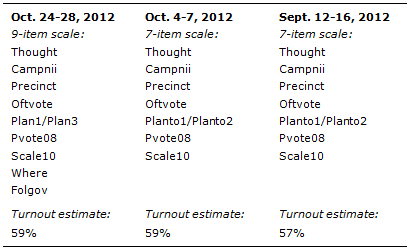The analysis in this report is based on telephone interviews conducted among national samples of adults, 18 years of age or older, living in all 50 U.S. states and the District of Columbia. Three surveys are referenced in this report: October 24-28, 2012 (2,008 adults; 1,204 interviewed on a landline telephone, 804 on a cellphone, including 433 who had no landline telephone); October 4-7, 2012 (1,511 adults; 906 interviewed on a landline telephone, 605 on a cellphone, including 291 who had no landline telephone); and September 12-16, 2012 (3,019 adults; 1,806 interviewed on a landline telephone, 1,213 on a cellphone, including 599 who had no landline telephone). Data collection was managed by Princeton Survey Research Associates International and conducted by interviewers at Princeton Data Source and Abt SRBI. A combination of landline and cell phone random digit dial samples were used; samples were provided by Survey Sampling International. Interviews were conducted in English and Spanish. Respondents in the landline sample were selected by randomly asking for the youngest adult male or female who is now at home. Interviews in the cell sample were conducted with the person who answered the phone, if that person was an adult 18 years of age or older. For detailed information about our survey methodology, see https://www.pewresearch.org/politics/methodology/
The combined landline and cell phone samples are weighted using an iterative technique that matches gender, age, education, race, Hispanic origin and nativity and region to parameters from the March 2011 Census Bureau’s Current Population Survey and population density to parameters from the 2010 Census. The sample also is weighted to match current patterns of telephone status and relative usage of landline and cell phones (for those with both), based on extrapolations from the 2011 National Health Interview Survey. The weighting procedure also accounts for the fact that respondents with both landline and cell phones have a greater probability of being included in the combined sample and adjusts for household size among respondents with a landline phone. Sampling errors and statistical tests of significance take into account the effect of weighting. The following table shows the unweighted sample sizes and the error attributable to sampling that would be expected at the 95% level of confidence for different groups in the survey:

Likely Voter Scale
The following table shows the questions in the likely voter scale for each survey and the turnout estimate used in identifying likely voters:

For full question wording of the turnout indicators, see the Oct. 24-28 topline. More details about the Pew Research Center’s methodology for estimating likelihood to vote are available at https://assets.pewresearch.org/wp-content/uploads/sites/5/2011/01/UnderstandingLikelyVoters.pdf